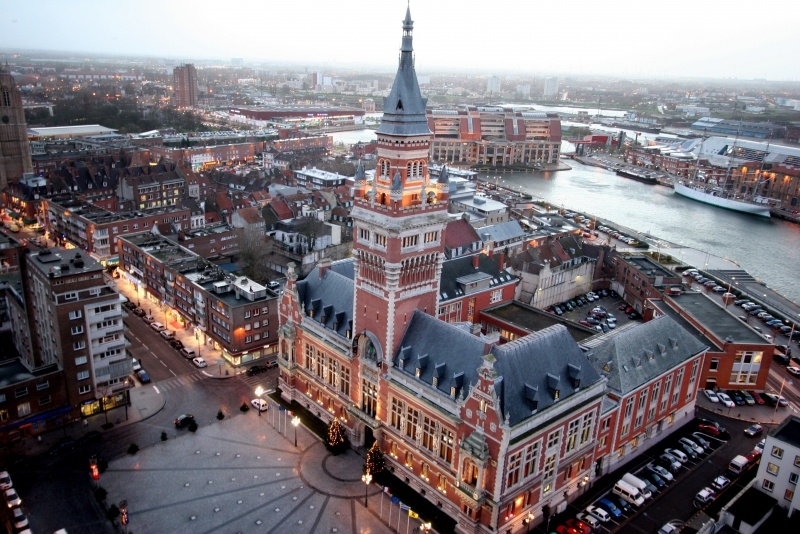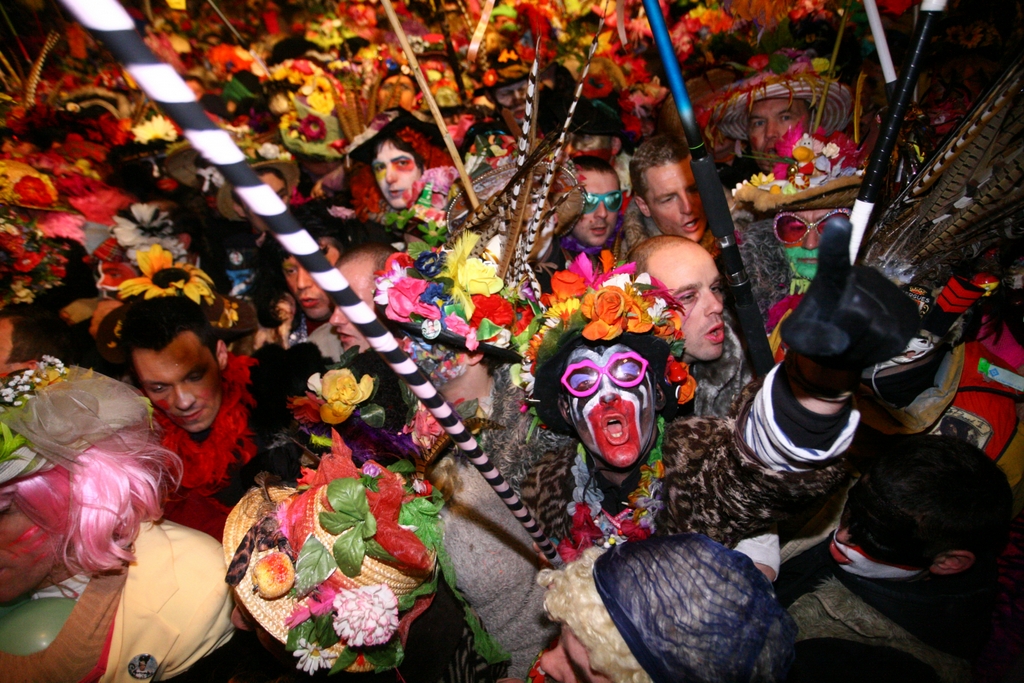Every year in Winter, the people of Dunkirk take over the streets to celebrate France’s noisiest carnival with a colourful vibe enjoyed by locals and tourists alike. Let’s find out more about the joyful Dunkirk Carnival.
Watch our short video presentation about Mardi Gras in France:
The Colourful Dunkirk Carnival

The colourful carnival of Dunkirk takes place from January to March. The event attracts an estimated 40,000 dressed-up revellers marching, dancing and singing on the town’s streets. The Dunkirk Carnival is often described as France’s oddest and maddest carnival.
Tradition has it that local fishermen feast with their families before heading to sea to fish off the coast of Iceland for six months. Ship-owners would then offer a ‘Foye’ to the fishermen, that is, an advance on their salary with a great party before the departure—the first mention of the carnival dates back to 1676.

Today, the festivities last from January to March. They comprise a series of balls and parades on weekend days in Dunkirk and nearby villages.
The culmination of the carnival takes place on the ‘Trois Joyeuses’ (Three Joyful Days), the Sunday, Monday and Tuesday preceding Ash Wednesday.
On these days, the town of Dunkirk embraces an atmosphere of excitement. Loud bands play on the streets, and revellers take over the town dressed in extravagant outfits carrying colourful umbrellas on long handles.

Understanding Dunkirk Carnival’s Unique Attire
A ‘cletche’ is more than just a costume or disguise in Dunkirk; it symbolises individuality and celebration.
This term, unique to Dunkirk, encapsulates the essence of the city’s carnival spirit.
Each cletche is distinct, embodying the carnival identity and personality of the wearer. There’s a sense of pride in donning a cletche, refining it over the years, and wearing it as a badge of honour in the carnival’s festivities.
Traditionally, clutches were simple, crafted from whatever was at hand, and often repurposed from women’s or grandmother’s wardrobes.
However, today’s clutches have evolved into more sophisticated, colourful, and diverse creations, often still incorporating upcycled materials.
It’s all about finding one’s unique cletche, avoiding imitation, and expressing personal flair. Modern costumes often reflect Dunkirk’s humorous spirit through their originality and the messages conveyed through badges and other accessories.

Elements of a Typical Dunkirk Carnival Costume:
- Hats: A key element, carnival hats have become increasingly prominent, floral, and colourful. Often made from recycled materials, they feature an array of decorations like feathers, badges, pins, plush toys, and even beer caps, reflecting the wearer’s personality.
- Fur Coats: Contrary to popular belief, not all men dress as women, nor is a fur coat mandatory. However, it’s a practical choice for its warmth and ample space for sewing patches, storing keys, and keeping a coin purse (pouncre). Some opt for old astrakans, but faux fur coats are popular, broader in the shoulder and more vibrant. These are readily available at Dunkirk’s Saturday market.
- Makeup: Preferably to masks, makeup transforms participants into unrecognisable yet distinct masquelours. It expresses the irrepressible desire to be a carnival-goer from head to toe. Lipstick, especially for men, is a crucial element.
- Footwear: Practicality reigns supreme regarding shoes, as the carnival involves staying on one’s feet for hours and traversing several kilometres. Safety shoes, easily sourced thanks to the region’s industrial development, are a smart choice. Comfortable, well-worn walking shoes with ankle support are recommended for enjoying the festivities.
- Other Accessories: The umbrella (or berguenaere), originally a mockery of rural civilians, has become a symbolic accessory. Elevated on a tall handle, it aids crowd navigation and group identification through its unique colours. Additional adornments include dusters, boas, false eyelashes, earrings, copious jewellery, suspender belts, tights, leg warmers, gloves, fanciful glasses, badges, and patches.
While personal expression is encouraged, there are a few taboos, such as military or police uniforms, religious figures, and overly sexy attire.
In Dunkirk’s carnival, the cletche is more than an outfit; it’s a vibrant expression of individuality and the joyous spirit of communal celebration.
![Dunkirk Carnival copyright Pichasso - licence [CC BY-SA 3.0] from Wikimedia Commons](https://frenchmoments.eu/wp-content/uploads/2016/01/Dunkirk-Carnival-01-copyright-Pichasso-licence-CC-BY-SA-3.0-from-Wikimedia-Commons-scaled.jpg)
The Dunkirch Carnival’s Traditions
The most popular outfit is the traditional yellow fishermen’s coat. It is worn by the Visshersbende (‘group of fishermen’ in Flemish).
Like many other towns in northern France, the revellers carry giant puppets across the city centre (Reuzes). Those of Dunkirk date back to the 1800s and measure up to eight metres high.
On the ‘Trois Joyeuses’ Sunday afternoon, everyone gathers in front of the city hall on Place Saint-Valentin. It is tradition for the crowd to demand ‘the herring they deserve’.
At around 5 pm, the mayor of Dunkirk comes out onto the belfry’s balcony. From there, he throws some 500 kg of herring into the crowd below. A real battle ensues as each carnival goer expects to catch his/her herring…

The final stage of the Dunkirk Carnival
The festivities continue on the Place Jean Bart at 7 pm for the Rigordon, the final stage of the Dunkirk Carnival. It includes a jig, a dance and a song sung by the carnavaleux (carnival-goers) on their knees and holding hands in honour of Jean Bart, Dunkirk’s naval hero.
![Dunkirk Carnival © Pichasso - licence [CC BY-SA 3.0] from Wikimedia Commons](https://frenchmoments.eu/wp-content/uploads/2016/01/Dunkirk-Carnival-02-copyright-Pichasso-licence-CC-BY-SA-3.0-from-Wikimedia-Commons-scaled.jpg)
The Dunkirk Carnival Programme
Although the Dunkirk Carnival officially started on the 6th of January 2024, the event will peak around Mardi Gras from the 10th to the 18th of February with the following programme:
- Saturday 10th February: Bal de l’Oncle Cô.
- Sunday 11th of February: Bande de Dunkerque, Bal des Acharnés.
- Monday 12th of February: Citadelle Band.
- Tuesday 13th of February: Rosendaël Band.
- Saturday 17th of February: Bal des Gigolos et Gigolettes.
- Sunday 18th of February: Malo-les-Bains band, Bal de la Violette.
Find out more about the event on the town’s tourist board website.
Featured image © Ville de Dunkerque


